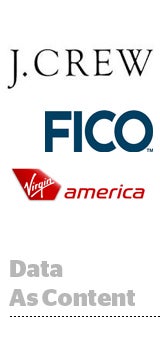 An underlying sentiment among the marketers at the Oracle Marketing Cloud Interact show in San Francisco this week was how to move away from “channel optimization” to maximizing customer lifecycle value.
An underlying sentiment among the marketers at the Oracle Marketing Cloud Interact show in San Francisco this week was how to move away from “channel optimization” to maximizing customer lifecycle value.
Many agreed change management is essential to avoid thinking of channels in isolation – from search to social to display.
“When I think about what marketing used to be, it was like being a movie producer (making executive decisions) and now it’s like being a farmer,” Luanne Calvert, VP and CMO of airline Virgin America said. “We have to plant seeds – conversations between our guests and our brands” to nurture the individual at every stage of the lifecycle.
Orchestrating data throughout the purchase funnel is a familiar challenge to Shannon Smith, VP of loyalty and retention marketing at J. Crew. In her previous role as a senior marketer with Sephora, Smith deployed customer analytics and developed the brand’s loyalty program Beauty Insider. Before Beauty Insider, Sephora had virtually no customer database.
“The loyalty program was designed to be a customer data capture tool, which would help us understand who a high value customer was, decipher different tiers and segment based off that,” Smith said in a Thursday session.
Except it wasn’t enough to construct a massive customer warehouse that consisted primarily of offline transactional data and purchase history. Sephora needed more insight into behavioral data to distinguish loyal from disloyal customers.
“Data is messy, it’s complicated and it’s quite an endeavor where and how you will capture it,” Smith said.
Now, at J. Crew, “we’re incorporating email engagement behavior into segmentation and targeting. We’re setting up a much more triggered and robust marketing platform. In all the marketing organizations I’ve worked, it’s helpful to have your end goal in mind.”
For Sephora, the goal was to tie loyalty data back to broader digital marketing efforts more effectively. For others, it’s using content to detect interest and intent and ascribing value to the consumer as opposed to thinking first about campaign or channel.
“We’ve made a lot of investments in technology to make our data more accessible to us,” said Brad Rodrigues, SVP and GM of digital for $500-million, California-based education technology company LeapFrog.
LeapFrog’s toolset includes Oracle commerce, Responsys for multi-channel marketing, Monetate for testing and targeting, Google Analytics, Adobe CQ and Birst for predictive analytics. By diversifying its technology stack, LeapFrog has become more proactive with data.
“We’re using data as content,” Rodrigues said. He cited an example of measuring LeapFrog’s app usage in order to tailor messaging to parents for suggested app downloads or device recommendations in a privacy-compliant manner. “It was similar at Nike, where I spent nine years, where we ran data to frame up insights and say to the user, ‘Did you know you ran 10 miles last week?’” and tailor offers accordingly.
At credit scoring and business services firm FICO, digital marketing has evolved from “campaign” to “nurture” mode, according to the company’s Director of Digital Marketing Kelly Rausch.
The company is becoming more proactive in determining “where the user is in the funnel and what content do we need to touch them with.”














